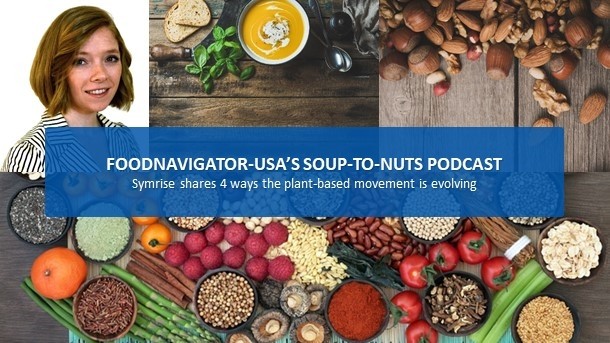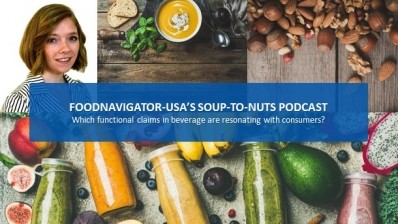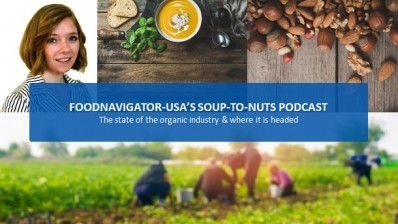Soup-To-Nuts Podcast: Symrise shares 4 ways that plant-based eating is becoming more sophisticated

According to the market research group ReportBuyer, the US plant-based meat market is growing at an impressive 24% compound annual growth rate and is expected to reach around $3 billion 2024. At the same time, Nielsen data compiled last summer for the Plant Based Foods Association estimated the non-dairy milk alternatives to be at $1.6 billion and plant-based cheese to be worth $124 million.
But this is just a small fraction of the overall plant-based market, which Global Market Insights estimates will hit $13 trillion by 2025 globally.
No doubt much of this growth will continue to come from meat and dairy analogues, but a significant bump also will come from increased consumer awareness of and demand for a wide range of fruits, vegetables, grains and legumes which consumers may not have known about or had access to previously.
Trendspotters with the global fragrance, flavor and food ingredient company Symrise reinforce this in their recently released 2019+ Top Trends in North America report, which calls out “Plant-Based Paradise” as a top trend to watch in coming years.
In this episode of FoodNavigator-USA’s Soup-To-Nuts podcast, Symrise Marketing and Consumer Insight Manager Dylan Thompson explains how a “surge in the creative use of plants and plant byproducts” will reshape plant-based eating in the coming years. He is also quick to point out that while Americans will eat more plants, they will not all become vegans or vegetarians. With that in mind he also shares a few trends for meat and cheese eaters.
Plant-based eating becomes more sophisticated
Plant-based may not sound like a flashy new trend to watch given it has been gaining traction over the last few years – especially in the dairy and meat alternative sets – but Symrise goes deeper than some trendspotters to reveal new, and sometimes unexpected aspects of the larger trend.
Thompson explains that the company’s 2019+ Top Trends for North America is based on surveys, interviews, conversations with top chefs and observations from food treks to restaurants, bars and shops across the country.
From this research, Symrise plucked four key drivers of plant-based eating that deserve innovators’ careful attention, including the rise of alliums, veggies being treated like meat, sprouting sweet and increased interest in THC.
The last point is much farther in the future than the others, according to Thompson, but that doesn’t make it a longshot. Earlier this week, the consumer research firm Nielsen revealed data from a recent survey that echoed Symrise’s prediction about Americans’ rising interest in THC – especially as it becomes legalized in more states.
It found that 34% of US adults older than 21 said they are interested in consuming legalized cannabis. For most people, they said they wanted to consume legal cannabis to help ease an ailment or for general wellness.
In particular, Nielsen reports, 85% of respondents said they’d consume cannabis to relieve chronic pain, 82% said to improve mental health and 80% said for minor injuries. After that, the most frequently noted reasons were to improve sleep, relax and to treat a non-pain medical condition.
What is driving plant-based eating?
Taking a step back to look at what is driving the increased interest in plant-based eating as whole, Thompson attributed it partly to increased access to information about the impact of animal agriculture on the environment and people’s health.
Research from the New Marketing Institute reinforces the idea that most consumers who are reducing meat are doing so for health reasons. According to the consulting group’s 2019 LOHAS Sustainability Report… Sustainable Foods!, about a third of consumers across all age groups are reducing their meat consumption for the same reasons: to improve their overall health, reduce their risk of heart disease and to lose weight.
Chicken rises to the top of meat eaters’ wish list
While many Americans are cutting back on animal protein, there are still many who want to eat meat. According to Symrise’s research those who do are more likely to reach for options that are healthier and come with a side of comfort.
“Chicken is bracing to become the king this year,” in part because meat-eaters still want animal protein but they want something with a healthier profile – and chicken fits the bill, Thompson said.
To keep chicken interesting, Thompson said, chefs are starting to bring more global aspects to the protein, but are still looking to make it comfortable by also incorporating familiar attributes.
Dairy as a superfood
Just as there is still room for meat in the American diet, Thompson said, there is also room for dairy – despite the rise in non-dairy options.
“One of our trends is called Future Looks Super, and it is all about what different super foods are growing and trending. So, one of those that we have seen is fermented alternative dairy,” such as cottage cheese, which is getting a facelift of late, Thompson said.
This is just a small sampling of the trends in Symrises’ report, which includes a total of 11 themes to watch in the coming years. Those interested in learning more can reach out to Symrise, but should also tune in to next week’s Soup-To-Nut podcast to learn about a few other longer-range trends the company is watching.

















